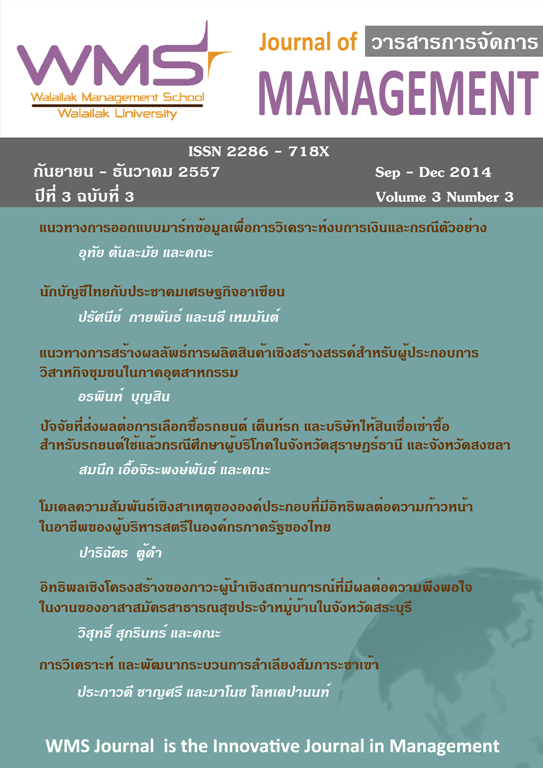Structural Influences of Contingency Leadership on Job Satisfaction of Village Health Volunteers in Saraburi Province
Main Article Content
Abstract
Article Details
References
กมลา สาครมณีทรัพย์. 2545. ปัจจัยที่ก่อให้เกิดการมีส่วนร่วมของชุมชนในการส่งเสริมสุขภาพ: ศึกษากรณีเฉพาะ: กรณีชุมชนหลังวัดลานบุญ.วิทยานิพนธ์สังคมสงเคราะห์ศาสตร์มหาบัณฑิต.กรุงเทพฯ: มหาวิทยาลัยธรรมศาสตร์.
กรมสนับสนุนบริการสุขภาพ. 2550. คู่มือการอบรมฟื้นฟูพัฒนาศักยภาพอาสาสมัครสาธารณสุขประจำหมู่บ้าน ปี 2550. นนทบุรี: โรงพิมพ์ชุมนุมสหกรณ์การเกษตรแห่งประเทศไทยจำกัด.
กรมสนับสนุนบริการสุขภาพ. 2552. การพัฒนางานสาธารณสุขมูลฐานในทศวรรษใหม่. วารสารสุขภาพภาคประชาชน ภาคกลาง. 24(2).4.
กรมสนับสนุนบริการสุขภาพ. 2554. คู่มือ อสม.ยุคใหม่. กรุงเทพมหานคร: โรงพิมพ์ชุมนุมสหกรณ์การเกษตรแห่งประเทศไทย.
โกมาตร จึงเสถียรทรัพย์และปารณัฐ สุขสุทธิ์. 2550. อาสาสมัครสาธารณสุข: ศักยภาพและบทบาทในบริบทของสังคมไทยที่เปลี่ยนไป.วารสารวิจัย ระบบสาธารณสุข: 1(3-4).268-269.
จีรวรรณ หัสโรค์และคณะ. 2550. การดำเนินงานสุขภาพภาคประชาชนเพื่อจัดการสุขภาพชุมชนขององค์กรอาสาสมัครสาธารณสุขประจำหมู่บ้าน.ศูนย์ฝึกอบรมและพัฒนาสุขภาพภาคประชาชน.ภาคตะวันออกเฉียงเหนือ. ขอนแก่น.
ทัศพร ชูศักดิ์และคณะ. 2555. รูปแบบความสัมพันธ์เชิงสาเหตุ ของปัจจัยที่มีอิทธิพลต่อการปฏิบัติงานตามบทบาทหน้าที่ของอาสาสมัครสาธารณสุขประจำหมู่บ้าน,พื้นที่สาธารณสุขเขต 18. วารสารสาธารณสุขและการพัฒนา.10(2).71-73.
พิชญาภา คำทอง. 2551. แบบภาวะผู้นำที่พึง ประสงค์ ของอาสาสมัครสาธารณสุขประจำหมู่บ้านในการส่งเสริมสุขภาพชุมชนลุ่ม แม่น้ำโขงของประเทศไทยและสาธารณรัฐ
ประชาธิปไตยประชาชนลาว,วิทยานิพนธ์ปรัชญาดุษฎีบัณฑิต มหาวิทยาลัยราชภัฏสุรินทร์.
ไพจิตร ปวะบุตร. 2552. นานาทรรศนะกับการพัฒนางานสาธารณสุขมูลฐานในอนาคต. กรุงเทพฯ:โรงพิมพ์สำนักงานพระพุทธศาสนา.
มนตรี พิริยะกุล. 2553. ตัวแบบเส้นทางกำลังสองน้อยที่สุดบางส่วน. การประชุมวิชาการสถิติและสถิติประยุกต์ ครั้งที่ 11 ประจำปี 2553, กรุงเทพฯ.มหาวิทยาลัยรามคำแหง.
วรากร ทรัพย์วิระปกรณ์ และ ทรงวุฒิ อยู่เอี่ยม. 2551.แรงจูงใจในงานที่มีผลต่อความผูกพันในงาน,ของอาสาสมัครสาธารณสุข.วารสารศึกษาศาสตร์.19 (2). 59.
อมร นนทสุต. 2552. นานาทรรศนะกับการพัฒนางานสาธารณสุขมูลฐานในอนาคต.กรุงเทพฯ:โรงพิมพ์สำนักงานพระพุทธศาสนา.
Arvey, R.D.Bouchad,T.J., Segal, N.L.,& Ablaham,L.M. 1989. Job Satisfaction: Environmental and genetic components, Journal of Applied Psychology. 74. 187-192.
Best,John. 1977. Research in Education. New Jercy ;Prentice Hall,Inc.
Bass, B. M. 1985. Leadership: Good, better, best [Electronic version]. Organizational Dynamics.13(3). 26-40. Retrieved February 11, 2007 from Ebscohost database.
Chin, W.W. 2001. The Partial Least Squares Approach to Structure Equation Modeling. In Modern methods for Business Research:New Jersey: Lawrence Erlbaum Associates.
Cohen, J. M.& Uphoff, N.T. 1981. Rural Development Participation: Concepts and Measures for Project Design Implementation and Evaluation. Rural committee center International studies. Cornell University.
Cotton, J. L.,Vollrath, D. A., Floggatt, K. L. Lengnick-Hall, M. L., & Jennings, K. R. 1988. Employee participation: Diverse forms and different outcomes. Academy of Management Review. 13(1). 8-22.
Gilmer, B.1967. Building Organization commitment:The Socialization of Management in work Organizations. Journal of Administration
Science.
Harmon, J., Scotti, D. J., Behnson, S., & Farias, G. et al. 2003. Effects of high involvement work systems on employee satisfaction and service costs in veterans’ healthcare. Journal of Healthcare Management. 48(6). 393-406.
Herberg G. kicks and C. Ray Gullet. 1975. Organizations; Theory and Behavior; New York; McGraw-Hill. pp. 286-288.
House,R.J. and Mitchell,R.R. 1974. Path-goal theory of Leadership. Journal of Contemporary Business.3. 81-97.
Hsiao, C. C. 2004. The Impact between the Workers’ Participation System and Job Satisfaction, Organization Commitment and Job Involvement: an Empirical Study of Public Corporations in Taiwan. I-Shou University.
Itsara B., Sittichai Ch. and Natthawut A. 2010. Leadership, Empowerment, and Attitude Outcomes, The Journal of Behavioral Science. 5(1). 1-14.
Kanter.R.M. 1979. Power failure in management cir¬cuits. Harvard Business Review. 4.65-75.
Keith Douglas McCook. 2002. Organizational Perceptions And Their Relationships to Job Attitudes, Effort, Performance and Organizational Citizenship Behaviors, Doctor of Philosophy in The Department of Psychology, Louisiana State University and Agricultural and Mechanical College.
Lightfoot, Lawerence, Sara.1983. The good high school, Portraits of character and culture.New York. Basic Block. Inc.
Likert, R. 1970. A Technique for Measurement of Attitude. In G.F. Summer (Ed.).Attitudes measurement. New York: Rand Mcnally.
Locke, E. A., & Schweiger, D. M. 1979. Participation in decision-making: One more look. Research in organizational behavior. 1(10). 265-339.
Naiyana M. ,Wanchai D., Idsaratt R. 2010. A Causal and Effect Model in Psychological Empowerment to Job Satisfaction of Community Development Workers in the Southern Border Provinces, The International Conference on Graduate Students’
Research Work: A Joint Conference between the Faculty of Liberal Arts, Prince of Songkla University and the Malaysia National Writers Association (PENA).
Robbins, S. P. 1993. Organizational behavior. Prentice-Hall, Inc: 366-392.
Somech, A. 2003. Relationships of Participative Leadership with Relational Demography Variables: A Multi-Level Perspective. Journal
of Organizational Behavior. 24(8). 1003-1018.
Spector, P. E. 1986. Perceived control by employee: A meta-analysis of studies concerning autonomy and participation at work. Human Relations. 39 (11). 1005-1016.
United Nations Research Institute for Social Development. 1982. Human Development Report 2007. Bangkok: Keen Publishing.p.146
Weiss, H. M. & Cropanzano, R. 1996. Affective events theory: A theoretical discussion of the structure, causes and consequences of affective experiences at work. Research in organizational behavior. 18. 1-74.
Wright, P. M., & Boswell, W. R. 2002. Desegregating HRM: A review and synthesis of micro and macro human resource management. Journal of Management. 28(3). 247-276


